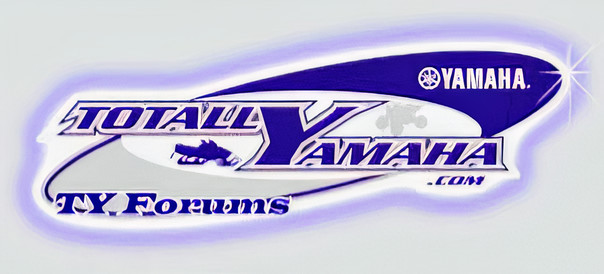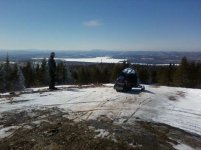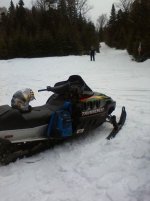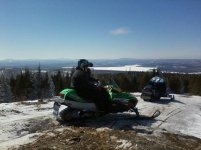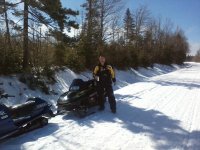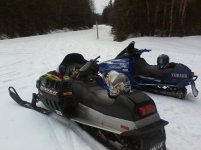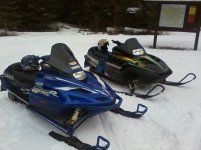brianbailey440
Member
in tuning the primary i have used 6 different springs to try to get a straight shift.all had similar results as far as top end rpm, and different results on engagement.im thinking the primary is as close as im gonna get it.now for the secondary,i changed the helix from a 51-43 to a 52-44.knowing that gearing up i gained acceleration,and going with a steeper helix, it shifts out faster/harder,will the secondary clutch require a stiffer secondary spring to compensate for the steeper helix angles?i have read that shallow helixs will provide more belt pressure at full shift out,and steeper helix angle will provide less pressure.i also read that gearing taller will require more secondary spring pressure also.how much of this is true, and how does it apply to what im trying to accomplish?am i going in the right direction by going to a stiffer secondary spring?another thing i have read is that loading the engine more will require either more turns out on the fuel screws, and or a bigger pilot jet.does this also hold true?your tuning knowledge is what im looking for to help me get to 105 in 1000 ft.what do you guys think?
Backwoods M Max
New member
From what I have read and found through my own experience that the green spring is the correct spring 95% of the time. After I got done with all my long tracking upgrades I called tom Hartman who said run a Silver spring it's what you want. Well it didn't work and I didn't know enough about clutching to realize what was happening so I spent a whole winter fighting with it. I had no up shift and the engine would start to over rev past 1/2 throttle. Needless to say on a mountain sled with no up shift and track speed I got stuck a lot and was really pissed why my sled wasn't working right. The rate and force jump is real high from green to silver. I think the srx drag guys like it because they throw so much weight at the motor it slows down the shift a little bit and keeps the belt from slipping in the secondary. I think in the red head it doesn't really work. Maybe on the drag strip but it would be tough to keep the sled trail rideable.
brianbailey440
Member
i hear what your saying,it didnt work for you in the mountains, but im not mountain riding.im using a really aggressive helix, and im thinking that i might need to slow the shift down a little.i mostly ride flat groomed trails, and drag race on the pond to 1000 ft.in aaens clutch tuning handbook chapter 4, page 17 it says that cam angles with a harder shiftout needs a stiffer spring with more pretension to work correctly.it wont hurt to try it since i allready have a new silver spring,so im gonna give it a shot.if it works, then great, if not,then ill go back to the green, no big deal.im thinking that i need to hold onto the belt a little more to get the acceleration that im looking for.maybe im wrong, but im gonna find out!!!
Backwoods M Max
New member
You might be in that 5% where you can get away with that spring. It sounds like your on the right track needing the extra pressure on an aggressive helix. With a 43 degree straight angle naht sooo much. It already back shifts fast so over sprung it wouldn't shift up. Even if that become the missing link to get it to perform for the 1000' it's easy enough to change the helix/spring for something that's a little more trail friendly.

staggs65
Moderator
Are you drag racing for a 1000ft or doing speed runs? 2 different things and require different setups.
brianbailey440
Member
drag racing mostly,but i like to see the numbers it will pull on radar.it gives me something to compare to when i make a change.i trail ride the sled, so im not looking to be the fastest sled,id like it to be quick to 1000 ft, but i also wouldnt mind being in the 103-105 mph range.99 was my best so far with limited traction.if it was hard packed, then im most likely to be close.track was too loose before,so i tightened it up a little.chain was a little too tight also, so i loosened it a little bit.just trying to get the best of both worlds, and learning along the way what works and what doesnt.ive been thinking id like to try 8 tooth drivers with a bigger lug track with 144 up the middle.it will slow me down a little,but will accelerate much harder out of the hole.just might try that next year.but for now,im gonna run it on the gun, and see what it does with the silver secondary spring.

staggs65
Moderator
For speed I like to go shallow helix angle with the red or green spring.
brianbailey440
Member
that seems to be the general consensus.what helix angle/angles are you running for speed runs?

staggs65
Moderator
I have zero experience with the redhead engines. In the powervalve engines I run helixes with a 10 degree spread and finish angles in the 30s. 34 to 38 on my viper, 36 to 40 on my srx
brianbailey440
Member
i dont think that there is a whole lot of hp difference in my bender piped sxr compared to a srx.power valves, or no power valves, they are both about the same hp.i tried a 49-37 helix on my sled, and it just doesnt cut it.it goes way better with a 51-43,and the 52-44.maybe its the weights im running.most people slap in the heaviest weights they can get, then clutch for the weights.ive never tried anything heavier than 89-10 a weights, so maybe thats it.certain weights require a certain helix angle to make it work.the profile has something to do with it for sure.and springs too.

staggs65
Moderator
Yes your primary setup will dictate your secondary setup not really a hp thing. Even though the hp might be close between your redhead and a powervalves sled I'm sure the primary setup is different. My viper and 780 srx were probably pretty close in peak hp, totally different primary setups. The torque/power curves will control primary setup not peak hp number.
100mph on the gun in 1000ft on snow is pretty darn good on a trail ridden sled. I rode my 780 srx to and from a 1000ft radar run on snow a few years back and did 102.1 on the gun. Beat out a bunch of 800s and a couple T-cats. The only sled that ran faster was a boosted Apex at 102.3. Now him and a couple Xcr's that were setup for ice not snow would have destroyed me had the ice track not been closed do to conditions.
100mph on the gun in 1000ft on snow is pretty darn good on a trail ridden sled. I rode my 780 srx to and from a 1000ft radar run on snow a few years back and did 102.1 on the gun. Beat out a bunch of 800s and a couple T-cats. The only sled that ran faster was a boosted Apex at 102.3. Now him and a couple Xcr's that were setup for ice not snow would have destroyed me had the ice track not been closed do to conditions.
brianbailey440
Member
exactly.100 mph is pretty good for a trail sled.im kinda surprised your 780 didnt go faster.im sure traction was a problem like im having.once i get it rolling a little off the line it hooks good and launches.but if it were on hard packed, im sure id be at 103-105.conditions will always dictate speed.hoping to have some snow on the pond by this weekend so i can test more.im gonna try to get some video and post it so you guys can see what im running for speeds.its supposed to be a mixed bag on wed, and turn colder after, so im hoping to get better traction off the line which should give me higher #s.when my sled was stock, all i could get was 92 in 1500 ft.gearing up made a huge difference for me, and also the primary weights/spring, and helix.im gonna make a few passes with the green spring, and then a few with the silver.hoping to see some improvement from the last time,ill find out this weekend.

staggs65
Moderator
Exactly.......conditions always play a role. 102.1 was best I could get on those conditions that day. As I said only one sled faster that day. The sled would definitely do more. Most sleds were under mid 90s that particular day.
brianbailey440
Member
still have a couple frozen ponds up here,not sure how thick it is, but im gonna find out.its been cold every nite making ice and i wanna test one more time before its gone.my buddy with the t-cat wants to go out too.im gonna pick a nice day, and make some passes.it aint over till the fat lady sings!!!
drew24
New member
She's been singing here for quite a while now. Actually most of the winter here. lolit aint over till the fat lady sings!!!
brianbailey440
Member
sad day, walked the pond and drilled some holes in the ice.cordless drill w/ a paddle bit, and there was only 4 inches out towards the middle,so needles to say, i give up for this year.unless i win powerball, and take the family on a trip, lol.
brianbailey440
Member
Quote:
"Where do I start ?
Focus on the primary and getting your engine rpm right.
That means right at PEAK HP with steady acceleration.
You’ll increase or decrease the weight and or profile (where the weight is distributed in the weight itself: heel, mid, tip) of the flyweights to achieve this.
Lighter weights raises the rpm heavier weights lower it.
Heel = bottom end, Middle = Mid-range, and Tip = top end.
Make sure you’re using the same profile of weight when you make changes or you’ll end up chasing your tail.
Do NOT change the secondary to adjust engine rpm.
I’ve seen too many people increase the pre-tension on their secondary to bring up their engine rpm, myself included.
You are shooting yourself in the foot !!!!
It decreases the efficiency of transmission of power to the track while adversely affecting the ability of the secondary to keep the shift curve flat.
Once you have your rpm where you want it, you next job is to get it to shift out the way you want. That’s the job of the secondary.
The combination of spring and helix is what determines this. Multi-angle is what I prefer.
The secondary spring directly equates to side-force on the belt.
The idea is that the more side-force you have on the belt, the less efficient it is because of belt drag.
Secondary pre-tension (wind) should be around 16-24 ft lbs.
What I try to do is get to the minimum side-force possible without slipping the belt in the secondary.
Too much side-force and the clutch will back-shift too fast and put you in too low of a ratio and over rev when you stab the throttle out of a corner.
Too little and it won’t back-shift fast enough and it will react sluggishly (bog) and you’ll loose rpm climbing hills or trying to maintain high speeds. "
// Tom Hartman.
( CEO of Hartman Inc. )
"Where do I start ?
Focus on the primary and getting your engine rpm right.
That means right at PEAK HP with steady acceleration.
You’ll increase or decrease the weight and or profile (where the weight is distributed in the weight itself: heel, mid, tip) of the flyweights to achieve this.
Lighter weights raises the rpm heavier weights lower it.
Heel = bottom end, Middle = Mid-range, and Tip = top end.
Make sure you’re using the same profile of weight when you make changes or you’ll end up chasing your tail.
Do NOT change the secondary to adjust engine rpm.
I’ve seen too many people increase the pre-tension on their secondary to bring up their engine rpm, myself included.
You are shooting yourself in the foot !!!!
It decreases the efficiency of transmission of power to the track while adversely affecting the ability of the secondary to keep the shift curve flat.
Once you have your rpm where you want it, you next job is to get it to shift out the way you want. That’s the job of the secondary.
The combination of spring and helix is what determines this. Multi-angle is what I prefer.
The secondary spring directly equates to side-force on the belt.
The idea is that the more side-force you have on the belt, the less efficient it is because of belt drag.
Secondary pre-tension (wind) should be around 16-24 ft lbs.
What I try to do is get to the minimum side-force possible without slipping the belt in the secondary.
Too much side-force and the clutch will back-shift too fast and put you in too low of a ratio and over rev when you stab the throttle out of a corner.
Too little and it won’t back-shift fast enough and it will react sluggishly (bog) and you’ll loose rpm climbing hills or trying to maintain high speeds. "
// Tom Hartman.
( CEO of Hartman Inc. )
Last edited:
